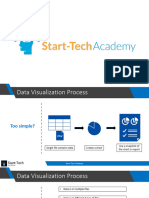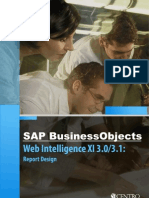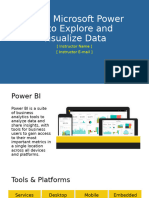0 ratings0% found this document useful (0 votes)
256 viewsTableau Desktop Fundamentals
This document provides an overview and outline of a Tableau Desktop Fundamentals course. The course is designed to teach students how to connect to and visualize data in Tableau, from basic to complex visualizations and dashboards. Key skills covered include connecting to data, filtering and sorting data, creating calculated fields, different visualization types like maps, charts, and dashboards, and sharing visualizations. The course contains 15 sections that progress from introductory concepts to advanced skills.
Uploaded by
Selvakumar ArunasalamCopyright
© © All Rights Reserved
Available Formats
Download as DOCX, PDF, TXT or read online on Scribd
0 ratings0% found this document useful (0 votes)
256 viewsTableau Desktop Fundamentals
This document provides an overview and outline of a Tableau Desktop Fundamentals course. The course is designed to teach students how to connect to and visualize data in Tableau, from basic to complex visualizations and dashboards. Key skills covered include connecting to data, filtering and sorting data, creating calculated fields, different visualization types like maps, charts, and dashboards, and sharing visualizations. The course contains 15 sections that progress from introductory concepts to advanced skills.
Uploaded by
Selvakumar ArunasalamCopyright
© © All Rights Reserved
Available Formats
Download as DOCX, PDF, TXT or read online on Scribd
You are on page 1/ 3
Tableau Desktop Fundamentals
COURSE OVERVIEW
This course is designed to help you understand and use the important concepts and techniques
in Tableau to move from simple to complex visualizations. You will also learn how to combine
them in interactive dashboards.
WHAT YOU'LL LEARN
TOP
Connect to your data
Edit and save a data source
Understand Tableau terminology
Use the Tableau interface / paradigm to effectively create powerful visualizations
Create basic calculations including string manipulation, basic arithmetic calculations, custom
aggregations and ratios, date math, logic statements and quick table calculations
Use Reference Lines to highlight elements of your data.
Use groups, bins, hierarchies, sorts, sets, and filters to create focused and effective
visualizations
Use Measure Name and Measure Value fields to create visualizations with multiple measures
and dimensions.
Handle changes in your data source such as field addition, deletion or name changes.
Share your visualizations with others.
Combine your visualizations into Interactive Dashboards and publish them to the web.
Represent your data using the following visualization types:
Cross tabs
Geographic maps
Heat maps
Distribution charts
Tree maps
Pie charts and bar charts
Dual axis and combo charts with different mark types
Box plots
Highlight tables
Scatter plots
OUTLINE
1. Introduction
Tableau Desktop and the Tableau Product Line
Application Terminology
Visual Cues for Fields
Getting Started in Tableau Desktop
Elements of a Visualization
2. Connecting to Data
Creating a Live Data Connection
Saving and Editing a Data Source
Metadata Grid
Understanding Changes to Data
Data Connection Options
Sharing Options
3. Simplifying and Sorting Your Data
Data Filtering
Creating Date Filters
Sorting
4. Organizing Your Data
Using Groups
Creating and Using Hierarchies
5. Slicing Your Data by Date
Working with Dates in Tableau
Using Discrete Date Parts
Defining a Fiscal Year
Creating Custom Dates
6. Using Multiple Measures in a View
Using Measure Values and Measure Names in a View
Combo Charts
Combined or Shared Axis Charts
Creating Dual Axis Charts
7. Showing the Relationship between Numerical Values
Creating Scatter Plots
Using Sets
8. Mapping Data Geographically
Mapping in Tableau
Geographic Mapping
Background Maps and Layers
Navigation and Selection in Maps
9. Viewing Specific Values
Creating Heat Maps
Creating Crosstabs
Creating Highlight Tables
Grand Totals, Sub-Totals, and Changing Aggregation
10. Customizing Your Data
Calculation Types
Parts of a Calculated Field
Options for Creating Calculated Fields
Strings, Dates, and Type Conversion Functions
Calculations and Aggregations
11. Analyzing Data with Quick Table Calculations
Using Quick Table Calculations
12. Showing Breakdowns of the Whole
Pie Charts and Parts of the Whole
Creating Tree Maps
13. Viewing Distributions
Bins and Histograms
Box and Whisker Plots
14. Highlighting Data with Reference Lines
Using Reference Lines
Reference Bands
Using the Analytics Pane
Instant Analytics
15. Making Your Views Available
Building Dashboards
Dashboard Actions
You might also like
- Course DA-100T00-A: Analyzing Data With Power BI: Audience ProfileNo ratings yetCourse DA-100T00-A: Analyzing Data With Power BI: Audience Profile10 pages
- Tableau Server Cluster InstallandConfig Instruction Document V 1.0No ratings yetTableau Server Cluster InstallandConfig Instruction Document V 1.012 pages
- SLR - Year 11 - Task 1 - Outdoor Recreation Task0% (1)SLR - Year 11 - Task 1 - Outdoor Recreation Task4 pages
- DESIGN and DEVELOPMENT OF CLOUD APPLICATIONSNo ratings yetDESIGN and DEVELOPMENT OF CLOUD APPLICATIONS3 pages
- DVC - All Questions and Answers - CT 1, CT 2 and Model - FinalNo ratings yetDVC - All Questions and Answers - CT 1, CT 2 and Model - Final114 pages
- Pecb Iso 38500 It Governance Manager Exam Preparation Guide100% (1)Pecb Iso 38500 It Governance Manager Exam Preparation Guide13 pages
- Creating Data Visualizations Using Tableau Desktop (Beginner) _ Map and Data LibraryNo ratings yetCreating Data Visualizations Using Tableau Desktop (Beginner) _ Map and Data Library48 pages
- Course Outline: Comptia A+: Audience ProfileNo ratings yetCourse Outline: Comptia A+: Audience Profile4 pages
- Leveling Up With SQL Advanced Techniques For Transforming Data Into Insights 9781484296851 9781484296844No ratings yetLeveling Up With SQL Advanced Techniques For Transforming Data Into Insights 9781484296851 9781484296844449 pages
- Tableau Desktop Training: About IntellipaatNo ratings yetTableau Desktop Training: About Intellipaat10 pages
- Course Outline - Essentials of Entrepreneurship and Small Business ManagementNo ratings yetCourse Outline - Essentials of Entrepreneurship and Small Business Management5 pages
- SQL Programming For Beginners The Ultimate Beginners Guide To Analyze and Manipulate Data With SQL (2020)No ratings yetSQL Programming For Beginners The Ultimate Beginners Guide To Analyze and Manipulate Data With SQL (2020)88 pages
- (M) BROCHURE - Data Science Learning PathNo ratings yet(M) BROCHURE - Data Science Learning Path33 pages
- Solutions Partner For Modern Work Walking DeckNo ratings yetSolutions Partner For Modern Work Walking Deck26 pages
- Introduction To R: Shanti.S.Chauhan, PH.D Business Studies ShuatsNo ratings yetIntroduction To R: Shanti.S.Chauhan, PH.D Business Studies Shuats53 pages
- Development of Integrated InfrastructureNo ratings yetDevelopment of Integrated Infrastructure64 pages
- Latham Information Technology and Social Transformation 2002No ratings yetLatham Information Technology and Social Transformation 200216 pages
- Full Download Visualizing Human Geography At Home in a Diverse World 2nd Edition Alyson Greiner PDF DOCX100% (6)Full Download Visualizing Human Geography At Home in a Diverse World 2nd Edition Alyson Greiner PDF DOCX70 pages
- Planner 20231031131706 Class Vi - Term 2 Teaching ProgrammeNo ratings yetPlanner 20231031131706 Class Vi - Term 2 Teaching Programme16 pages
- 7 Laws of Nature (Lecture Notes by Arch't Ryan Cabanlit)No ratings yet7 Laws of Nature (Lecture Notes by Arch't Ryan Cabanlit)4 pages
- Module 3 User's Guide - Planning and Assessing Health Worker ActivitiesNo ratings yetModule 3 User's Guide - Planning and Assessing Health Worker Activities149 pages
- The Routledge Handbook of Mapping and Cartography: Arcwatch July 2018. Accessed July 23, 2018No ratings yetThe Routledge Handbook of Mapping and Cartography: Arcwatch July 2018. Accessed July 23, 20185 pages
- A Fieldwork Investigation of My Local Area's Human and Physical Geography PDFNo ratings yetA Fieldwork Investigation of My Local Area's Human and Physical Geography PDF11 pages
- A Proposed Revitalization of Urban Park in Talamban - THESIS REVISEDNo ratings yetA Proposed Revitalization of Urban Park in Talamban - THESIS REVISED220 pages
- [Ebooks PDF] download CRAFTING YOUR THESIS Making Use of Qualitative Approaches 1st Edition Johan Alvehus full chapters100% (5)[Ebooks PDF] download CRAFTING YOUR THESIS Making Use of Qualitative Approaches 1st Edition Johan Alvehus full chapters81 pages

























































































